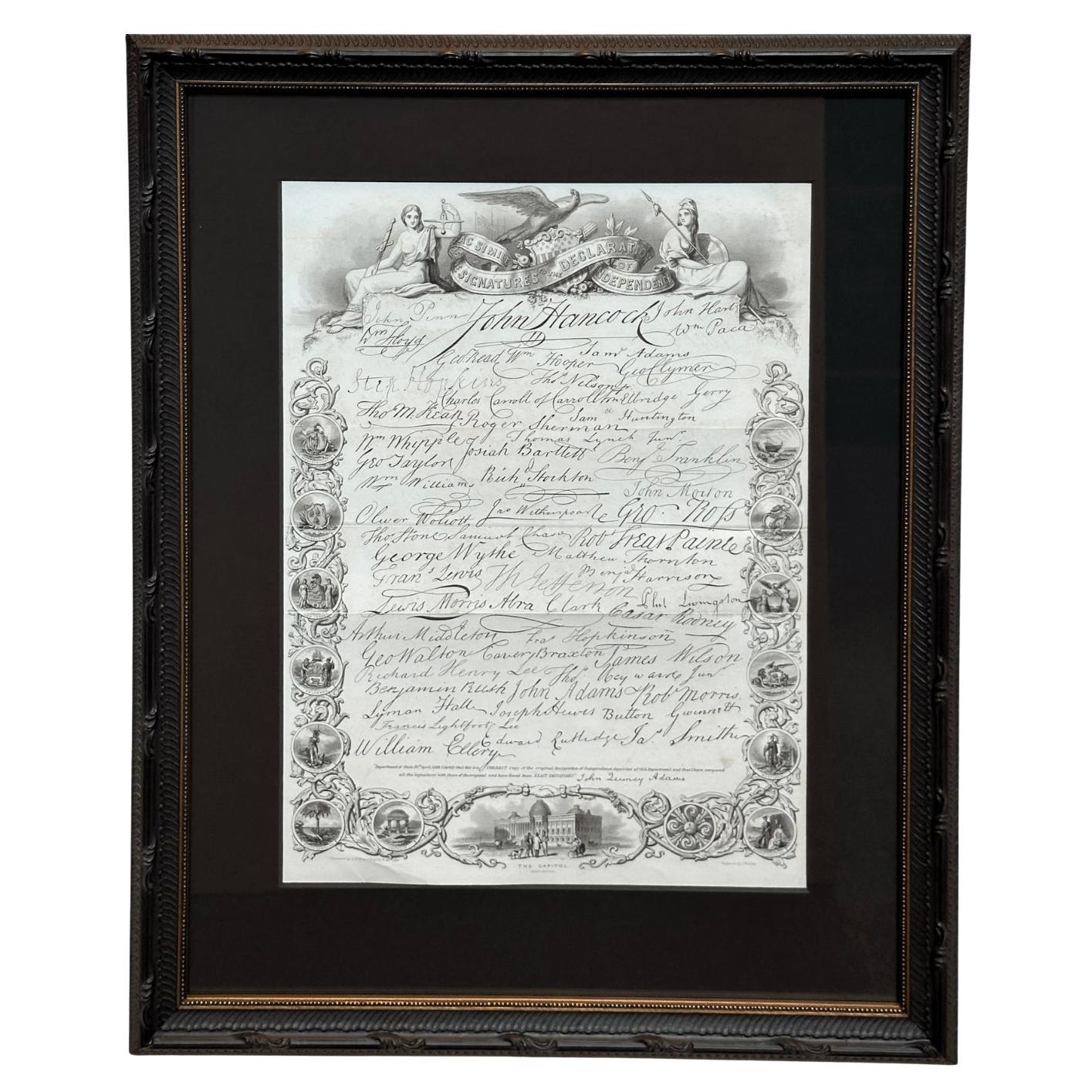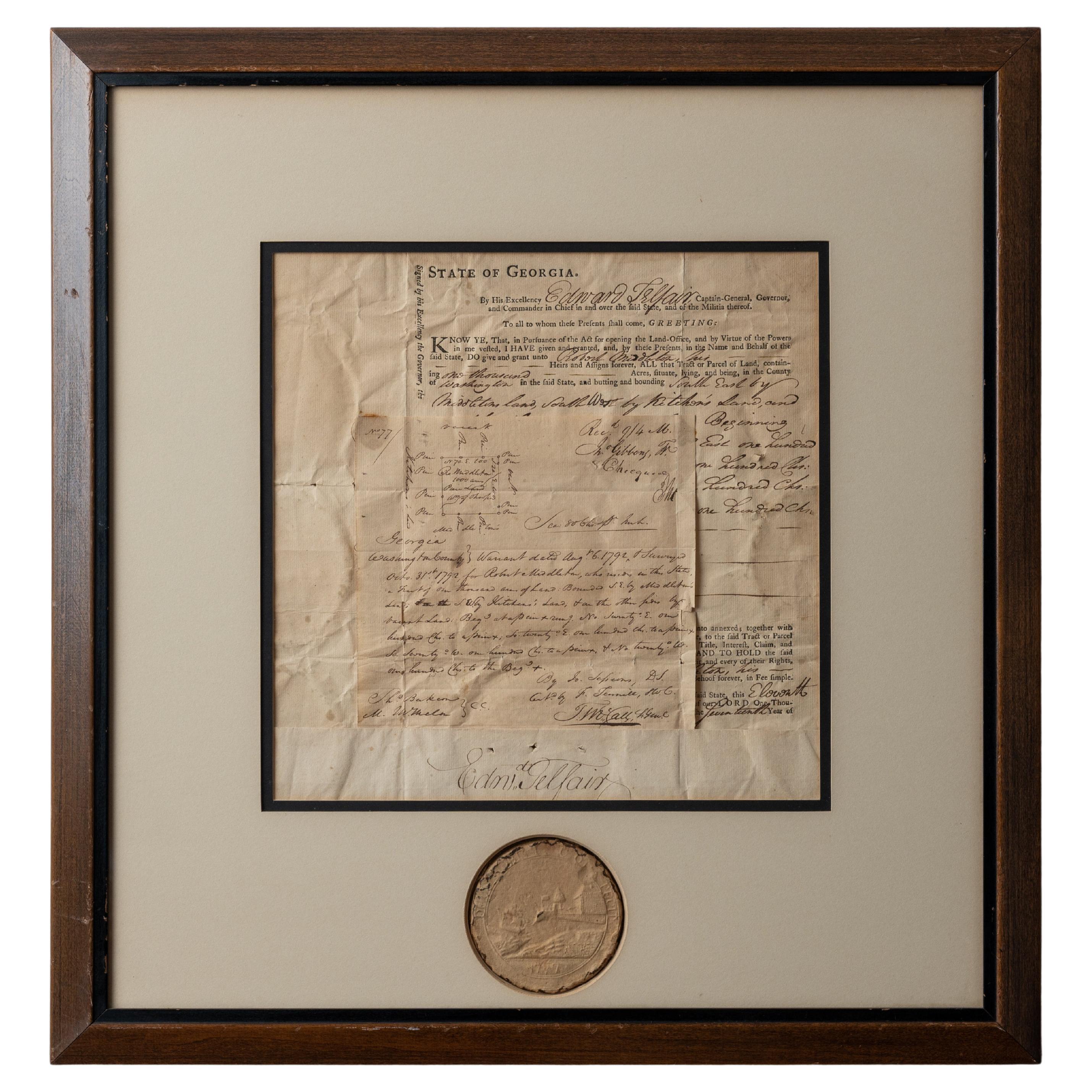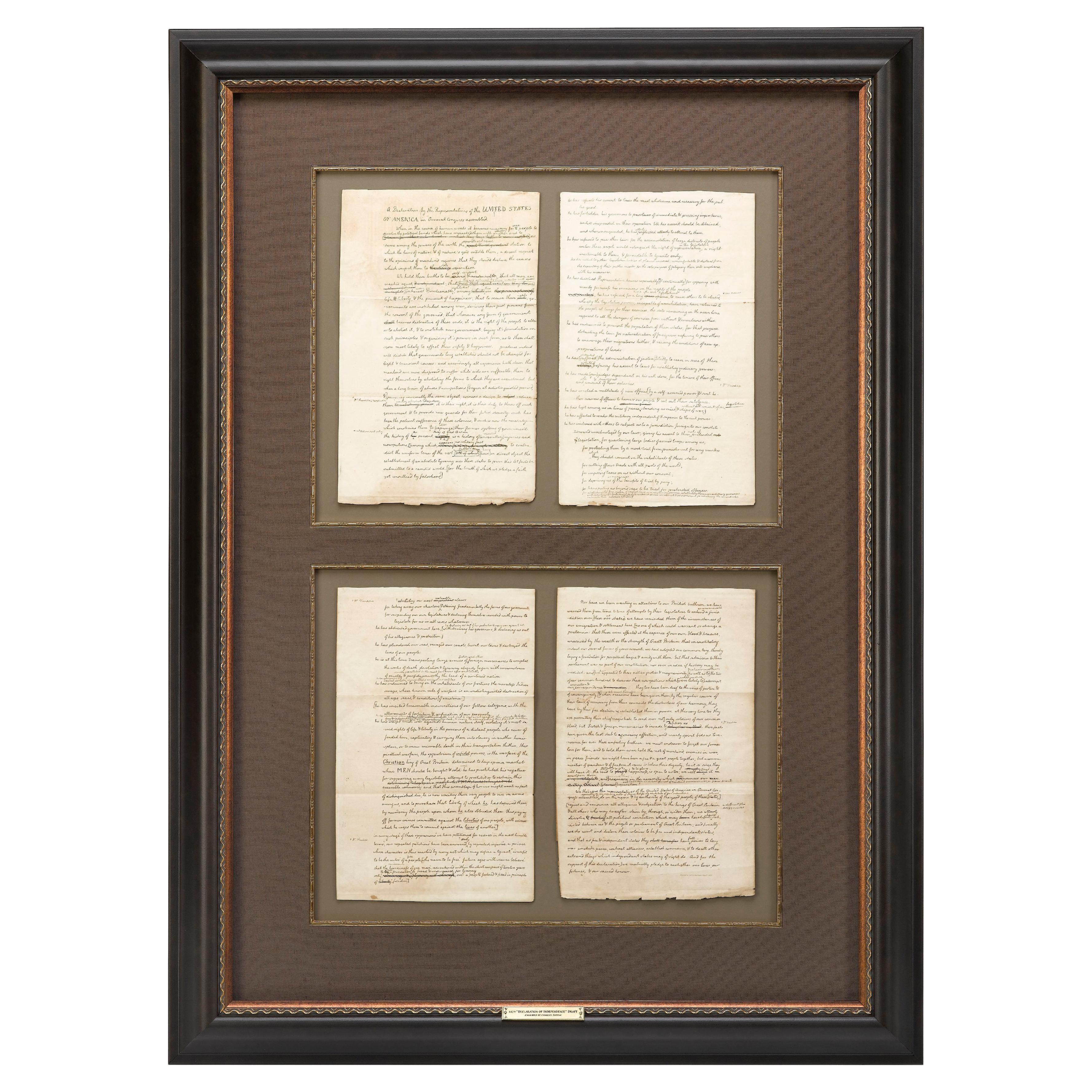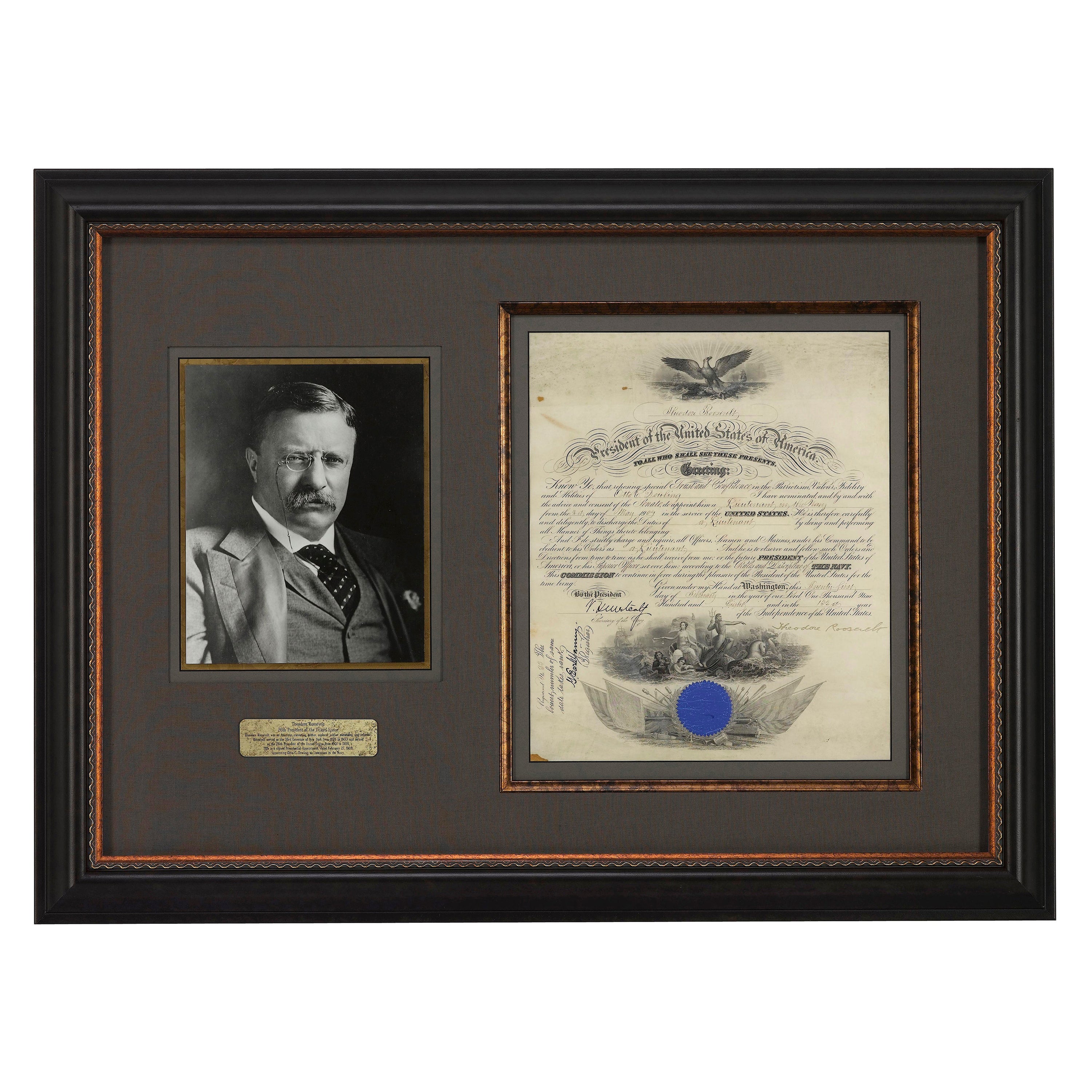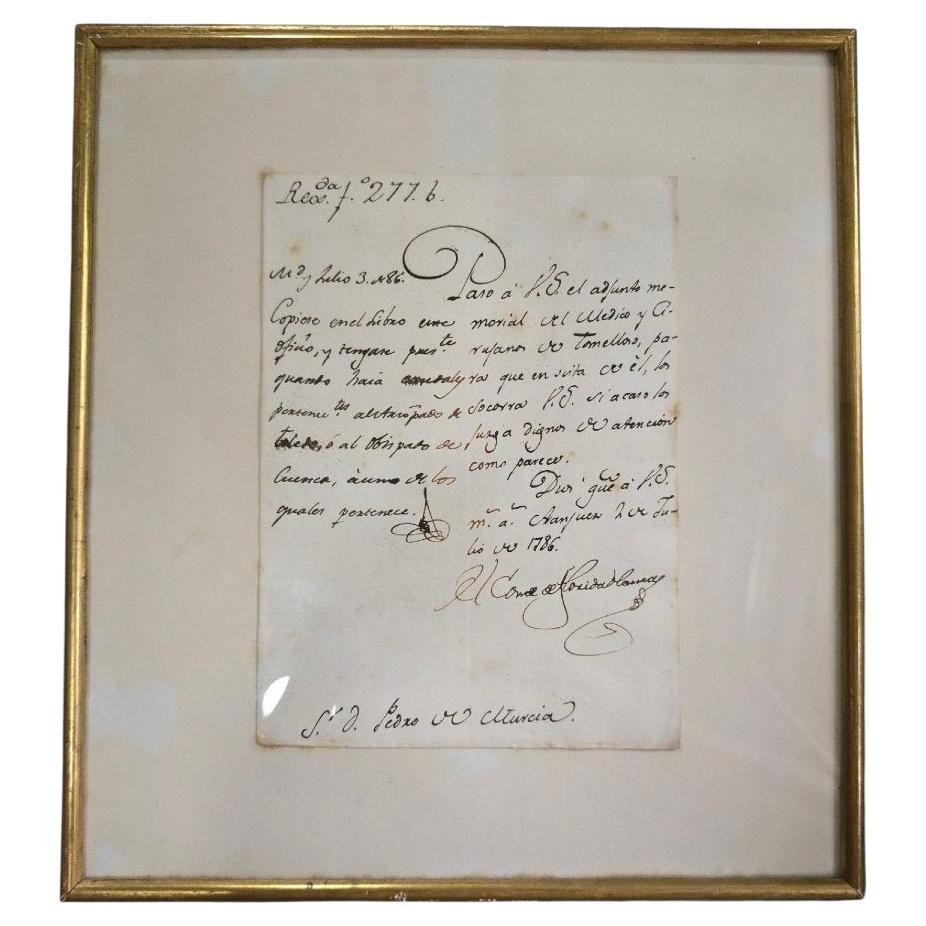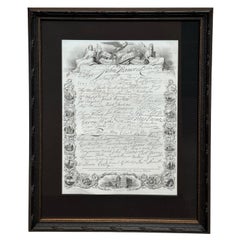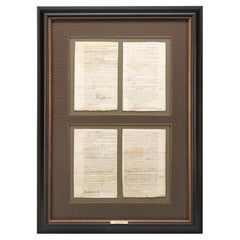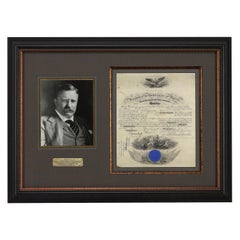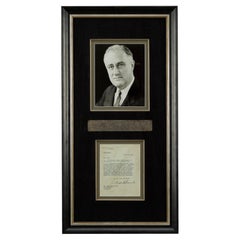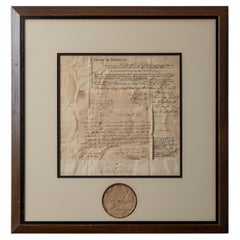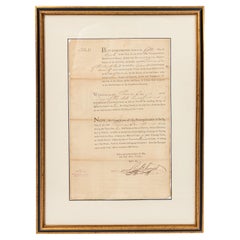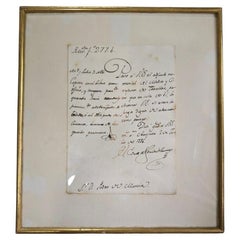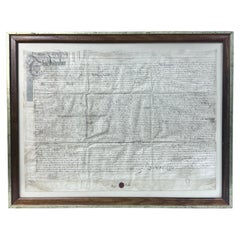Items Similar to Thomas Jefferson and James Madison Ship's Passport Signed, November 5, 1804
Want more images or videos?
Request additional images or videos from the seller
1 of 7
Thomas Jefferson and James Madison Ship's Passport Signed, November 5, 1804
$29,500
£22,168.21
€25,710.10
CA$41,413.62
A$45,954.56
CHF 24,239.90
MX$561,006.99
NOK 306,682.15
SEK 287,232.64
DKK 191,869.61
About the Item
This rare official document, dated November 5, 1804, is signed by both Thomas Jefferson as the nation's third President and James Madison as Secretary of State. The document, partially printed in columns and finished by hand in ink, consists of ship's papers for the New York Packet, then moored in New York and bound for Bristol.
In four columns printed and engrossed in French, Spanish, English, and Dutch is the New York Packet’s manifest. The paper names “Matthew Dunnett of New York” as its "master and commander," identifies its tonnage at 286 3/95 “tons or thereabouts” and cargo as “laden with Ashes, Turpentine, Old Copper, Staves & Boards." It indicates its destination as "Bristol." The document contains oaths that the named ship is owned by “one or more of the citizens of the United States, and to him or them only.”
Along the middle right, the manifest is signed “Th: Jefferson," above the signature of his Secretary of State “James Madison," and is countersigned by “David Gelston” Deputy Collector of Customs. This rare document also contains two embossed paper seals of the United States affixed at middle and lower left. In four columns below are official printed and engrossed requests for safe passage, again in four languages. It asks of those that encounter the ship, and “who shall see these patents, or hear them read” to “please receive the said matter with goodness, and to treat him in a becoming manner, permitting him, upon the usual tolls and expenses, in passing and repassing, to pass, navigate, and frequent the ports, passes, and territories, to the end to transact his business, where, and in what manner he shall judge proper.”
Ship’s papers are documents legally required to be carried by an oceangoing vessel, as a certificate of registry, logbook, and cargo manifest. Ship’s papers have occupied a prominent place in the history of maritime law and in treaties of commerce and navigation. Signed presidential authorization such as this, granting the right to sail the high seas and dock in a country's ports, was a valuable privilege. Before conferring such privilege, officials were required to establish the legitimacy of a vessel, its cargo and its personnel, and the ship's papers were intended to authorize its mission. In the wrong hands, especially during the tense and vulnerable conditions of wartime or, as in the perilous years of America's beginnings, when privateers often seized ships and their cargo, a fraudulent or forged approval could be dangerous. Having presidential-signed ship papers stating your neutrality on the open waters helped offset some of the risk involved in the dangerous yet lucrative trade business.
In February of 1793, France declared war on England. These developments were a source of political and economic trouble for the United States, for while the nation was still formally allied with France under the Treaty of 1778, it was not prepared to take sides in an international conflict. While Washington had issued a proclamation of neutrality, in practice, neither the French nor the British respected that official position, and American ships, especially those carrying provisions, would be harassed and seized by both over the course of the year. Ship's papers such as this were used to establish proof of nationality and guarantee protection for ships. "By providing a statement of American property, signed by the President of the United States … [ship's papers were] intended to confirm our status as a neutral nation, when international conflict put added dangers on America's commerce at sea" (Stein, American Maritime Documents 1776-1860, 113-114).
The official text of such documents was revised several times in 1793, in direct response to the political upheaval caused by the war and the increasingly fraught American trade with the French and British ports and towns. The language of this ship’s paper outlines the very mercantile rights that were routinely abused by an aggressive Royal Navy. The issues of ship seizure, privateering, and impressment were growing points of contention between America and Great Britain in the early 1800s, eventually culminating in the War of 1812.
This is a one-of-kind item, delving into the early American history of maritime law and our trade network with Great Britain during our nascent years as a country.
CONDITION:
Very good condition. 1p. Folio, partially printed, partially inscribed. The document is in much better condition than usually seen, with a large and very bold Jefferson signature, a fine Madison signature, and two intact white paper seals. Document was issued folding, with four horizontal fold lines and one prominent vertical fold. A small chip to the right margin. Wrinkles to documents near paper seals.
Document is archivally framed to the highest standards, with two printed portraits on either side, in a custom built wooden frame with acid-free black mats, gold spandrels, museum glass, and a custom gold leaf plaque.
Framed Dimensions: 30" H x 66" W x 2 1/4" D.
Accompanied by our company's letter of authenticity.
- Dimensions:Height: 30 in (76.2 cm)Width: 66 in (167.64 cm)Depth: 2.25 in (5.72 cm)
- Style:Federal (Of the Period)
- Materials and Techniques:
- Place of Origin:
- Period:
- Date of Manufacture:1804
- Condition:Additions or alterations made to the original: Framed to archival and conservation standards by Art Source International Framing in Boulder, CO in August of 2025. Wear consistent with age and use. Minor fading.
- Seller Location:Colorado Springs, CO
- Reference Number:Seller: AS2341stDibs: LU909746225552
About the Seller
4.9
Platinum Seller
Premium sellers with a 4.7+ rating and 24-hour response times
Established in 2010
1stDibs seller since 2011
463 sales on 1stDibs
- ShippingRetrieving quote...Shipping from: Colorado Springs, CO
- Return Policy
Authenticity Guarantee
In the unlikely event there’s an issue with an item’s authenticity, contact us within 1 year for a full refund. DetailsMoney-Back Guarantee
If your item is not as described, is damaged in transit, or does not arrive, contact us within 7 days for a full refund. Details24-Hour Cancellation
You have a 24-hour grace period in which to reconsider your purchase, with no questions asked.Vetted Professional Sellers
Our world-class sellers must adhere to strict standards for service and quality, maintaining the integrity of our listings.Price-Match Guarantee
If you find that a seller listed the same item for a lower price elsewhere, we’ll match it.Trusted Global Delivery
Our best-in-class carrier network provides specialized shipping options worldwide, including custom delivery.More From This Seller
View All"Facsimile of the Signatures to the Declaration of Independence" by A.H. Wray
Located in Colorado Springs, CO
Presented is a handsome steel engraving, a patriotic composition of the facsimile signatures of the signers of the Declaration of Independence. The engraving is from John H. Hinton’...
Category
Antique 1850s American Federal Prints
Materials
Paper
1829 "Declaration of Independence" Draft, Engraved by Charles Toppan
Located in Colorado Springs, CO
This historical and rare item celebrates one of the most influential writers, politicians, and American Revolutionary figures, Thomas Jefferson. Featured is a four-page facsimile ste...
Category
Antique 1820s American Federal Prints
Materials
Paper
Theodore Roosevelt Signed Presidential Appointment, Dated February 27, 1908
By Theodore Roosevelt
Located in Colorado Springs, CO
Presented is a Theodore Roosevelt signed Presidential Appointment of Otto C. Dowling to “Lieutenant on the Navy,” dated February 27, 1908. The appointment is countersigned by the Sec...
Category
Antique Early 1900s American Historical Memorabilia
Materials
Paper
Franklin D. Roosevelt Signed Letter, 1942
Located in Colorado Springs, CO
Presented is an original signed letter from President Franklin D. Roosevelt to the Honorable John Godfrey Saxe, a NY lawyer and State Senator. The one-page typed letter is written on...
Category
Vintage 1940s American Historical Memorabilia
Materials
Paper
The Lives of the Signers of the Declaration of Independence by N. Dwight, 1860
Located in Colorado Springs, CO
Dwight, Nathaniel. The Lives of the Signers of the Declaration of Independence. New York: A. S. Barnes & Burr, 1860. Later printing. Octavo. Rebound in ¼ leather and cloth boards, wi...
Category
Antique 1860s American Federal Books
Materials
Leather, Paper
The Works of Dr. Benjamin Franklin, with His Life, Written by Himself, 1835
By Benjamin Franklin
Located in Colorado Springs, CO
Franklin, Benjamin. The Works of Dr. Benjamin Franklin, Consisting of Essays, Humorous, Moral, and Literary, with His Life, Written by Himself. Exeter: J & B Williams, 1835. In origi...
Category
Antique 1830s American Federal Books
Materials
Leather, Fabric, Paper
You May Also Like
Pine Barrens Speculation, Edward Telfair Georgia Land Grant, 1792
Located in Savannah, GA
Washington County, Georgia land deed with survey warrant and beeswax state seal granted by Governer Edward Telfair to Col. Robert Middleton.
This la...
Category
Antique Late 18th Century American American Classical Historical Memorab...
Materials
Glass, Wood, Paper
18th Century Inn License in a Gilt Frame
Located in Queens, NY
Original 1790 NY state inn license letterpressed in a faux gilt and lacquer frame.
Category
Antique 19th Century American Country Prints
Letter signed by the Count of Floridablanca – 1786
Located in Madrid, ES
Rare historical document: handwritten letter signed in 1786 by José Moñino y Redondo, better known as the Count of Floridablanca, a prominent 18th-century Spanish political figure an...
Category
Antique Late 18th Century Spanish Other Historical Memorabilia
Materials
Paper
Early 18th Century English Framed Indenture Document, Framed
Located in Bradenton, FL
A Large Early 18th Century Framed Indenture Document. The document (deed) is written in lengthy hand-written detail. Issued in three parts, indentures were legal documents cut with w...
Category
Antique Early 18th Century English George II Historical Memorabilia
Materials
Animal Skin, Wood
Mid-19th Century American Stationary with Manuscript Letter, Signed 1854
Located in Langweer, NL
American stationery with in the top the following text printed:
E pluribus unum – Latin for "Out of many, one" (also translated as "One out of many" or "One from many") – is a traditional motto of the United States, appearing on the Great Seal along with Annuit cœptis (Latin for "he approves the undertaking [lit. 'things undertaken']") and Novus ordo seclorum (Latin for "New order of the ages"); its inclusion on the seal was approved by an Act of Congress in 1782. While its status as national motto was for many years unofficial, E pluribus unum was still considered the de facto motto of the United States from its early history. Eventually, the United States Congress passed an act (H. J. Resolution 396), adopting "In God We Trust" as the official motto in 1956.
The thirteen letters of E PLURIBUS UNUM makes its use symbolic of the thirteen original states like the thirteen stripes on the US flag. The meaning of the phrase originates from the concept that out of the union of the original Thirteen Colonies emerged a new single nation. It is emblazoned across the scroll and clenched in the eagle's beak on the Great Seal of the United States. (Source: wikipedia)
Text below the portraits: "The Presidents of our Great Republic."
Letter paper with hand-colored engraving showing the portraits of the 14 presidents of the USA from George Washington up to Franklin Pierce...
Category
Antique 1850s Prints
Materials
Paper
$429 Sale Price
20% Off
1780s American Revolutionary War Bond, State of Connecticut in Black Frame
Located in Yonkers, NY
An American Revolutionary war bond from the State of Connecticut from circa 1782 in custom black frame under glass. Step into the pages of history with this authentic American Revolu...
Category
Antique Late 18th Century North American Prints
Materials
Glass, Wood, Paper
More Ways To Browse
Vintage Fairground Memorabilia
All 12 Apollo Nasa Moonwalker
Antique German Kugel Ornament
Barrow Hepburn Gale
Barrow Hepburn
Drive In Movie Speaker
Princess Diana Christmas Card
Vintage Shaving Brush
Yale Memorabilia
Absinthe Spoon
Air Raid Siren
Antique English Spring Balance Scale
Antique Gamewell Fire Alarm Box
Hms Foudroyant
Antique Christmas Bird Ornaments
Antique Railroad Switch
Art Deco Mailbox
Garcia Bits
